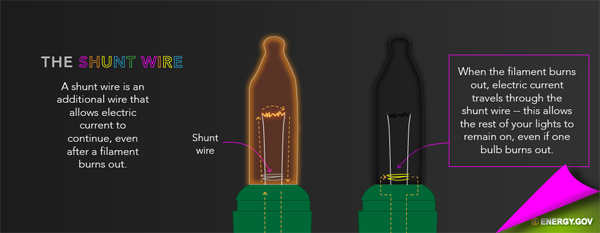Review It
Using the knowledge you have gained, continue reading and thinking about the author’s purpose and the method (textually and visually) that the author uses to achieve the overall purpose.
- Why did the author use text to explain technical information?
- Why did the author use a visual to illustrate technical information?
- How are the text and visuals working together to reveal the author’s purpose?
In the following activities, you will read another section of the article and think about the author’s purpose in creating a visual. Remember, the author’s overall purpose is that incandescent light strands can teach us a lot about the flow of electric current. The author continues to reveal this purpose in the following section of text by explaining shunts and fuses simplistically. In this activity, you should be able to explain the connection between the text and the visual.
Now read the paragraphs 12- 17 of the holiday lights article from “Energy.gov Opens a new window” and complete the follow-up activities.
Shunts and Fuses Save the Day
12 A shunt is any device that allows current to continue flowing through a circuit by creating a path of lower resistance than the original path. In incandescent holiday lights, shunts are small wires wrapped beneath the filament. Initially, they are coated with a substance that makes them an insulator. In other words, electricity cannot pass across the shunt as long as the filament exists, because the coating gives the shunt a higher resistance initially than the filament, and the electrical current avoids the shunt in order to find the path of least resistance, through the filament.
13 If the filament burns out, however, the high temperature from the burnout will cause the substance coating the shunt to melt off, revealing the lower resistance wire beneath. Now the shunt has gone from an insulator to a conductor, and current passes along the shunt, keeping the circuit closed, and the remaining lights burning. Check it out below.

14 The last thing to understand about how holiday lights work is the role of the fuse. Recently, as I was putting up lights, I tripped on a wire and the lights went out. The string of lights remained plugged in so I was stymied as to what happened. I unplugged, replugged … unplugged, replugged the string. Nothing. Then it came to me. "The fuse!" I said under my breath. I must have caused some sort of short circuit when I jolted the wire.
15 Fuses are important safety features for many electrical appliances, but most of us don't even know that they're there. In holiday lights, the fuse can be found near the part of the strand that plugs into the wall, often called -- and I'm not making this up -- the male end of the wire. Normally, the fuse is accessible through a small plastic door in the plug that can be opened and closed for replacing the fuse.
16 As the electrical current within a wire increases, the wire can heat up, at times causing melting or even fires. To prevent this, fuses were introduced as so-called “sacrificial devices” (so very selfless of them!). When the current increases past a safe level, instead of the wire melting or your Christmas tree catching fire, the fuse safely breaks the circuit, averting many disastrous scenarios.
17 Fuses are typically small sections of replaceable wire, rated to a maximum current level. Because they are more delicate than the rest of the wiring, a fuse will burn out before overcurrent has an opportunity to overheat other portions of the light strand. When a fuse breaks, the circuit becomes incomplete and current cannot flow through the remainder of the circuit.
- Energy.gov - "How Do Holiday Lights Work?opens a new window"


